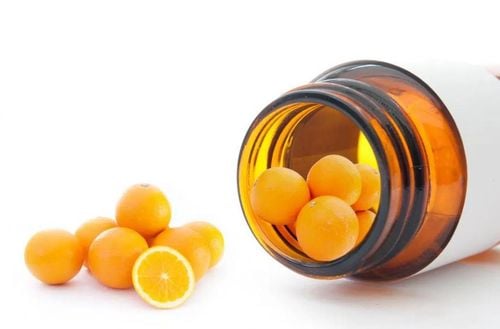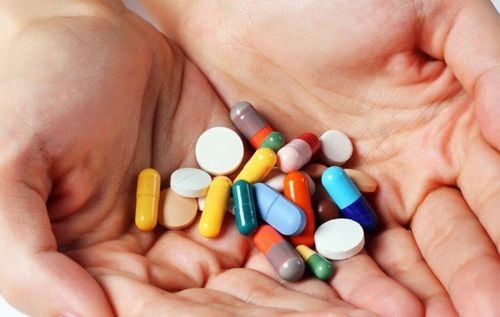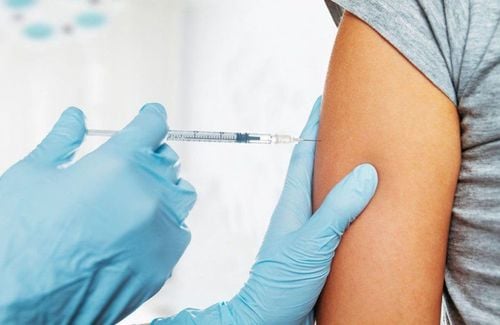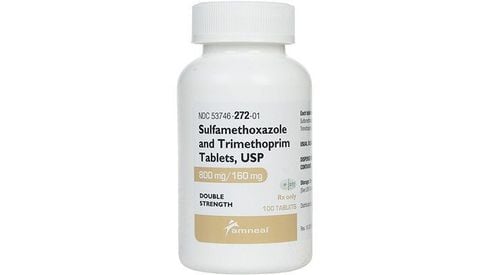This is an automatically translated article.
Cefazolin 1g and Cefazolin 2g are drugs for the treatment of infections (not for severe infections) such as lower respiratory tract infections, skin and skin structure infections, bone and joint infections. There is a lot of information about Cefazolin on the market today, but it is still incomplete. To better understand what Cefazolin is, what are the uses of Cefazolin, please read more articles below.
1. What is Cefazolin?
Cefazolin 1g and Cefazolin 2g are the first generation bactericidal cephalosporin antibiotics for parenteral administration. Prepared in the form of powder for solution for infusion of 1 gram and 2 grams.
The drug is prescribed by doctors to treat the following infections caused by microorganisms sensitive to Cefazolin:
Skin and soft tissue infections Bone and joint infections. Prophylaxis before surgery. For surgical operations with a high risk of infection with anaerobic pathogens, e.g. colorectal surgery, an appropriate drug with activity against anaerobic bacteria should be combined.
2. What are the uses of Cefazolin?
2.1 Pharmacodynamics Cephalosporins inhibit cell wall synthesis (during the growth phase) through blocking penicillin-binding proteins (PBPs) such as transpeptidases. The result is a bactericidal effect.
2.2. Pharmacokinetics * Absorption
Cefazolin is administered parenterally. After 500mg intramuscular injection, the maximum serum concentration obtained after about one hour is 20-40 micrograms/mL. After administration of 1g, a maximum serum concentration of 37-63 micrograms/mL was obtained. In a continuous intravenous infusion study Cefazolin in healthy adults at a dose of 3.5 mg/kg over one hour (approximately 250 mg) then 1.5 mg/kg over the next two hours (approximately 100 mg) , steady-state serum concentrations are approx. 28 micrograms/mL was demonstrated in the third hour. The following table shows the mean serum concentrations of cefazolin following a single intravenous dose of 1 g.
Serum concentration (μg/mL) after intravenous administration of 1g
| 5 phút | 15 phút | 30 phút | 1 giờ | 2 giờ | 4 giờ |
| 188.4 | 135.8 | 106.8 | 73.7 | 45.6 | 16.5 |
* Allocations
Cefazolin for 70% - 86% bound to plasma proteins. The volume of distribution is about 11 L / 1.73 m 2 . When Cefazolin is administered to patients without biliary obstruction, antibiotic concentrations 90-120 minutes after administration are usually higher than serum antibiotic concentrations.
In contrast, where there is an obstruction, antibiotic concentrations in bile are much lower than those in serum. Following therapeutic dosing in patients with meningitis, varying concentrations of cefazolin from 0 to 0.4 micrograms/mL were measured in the cerebrospinal fluid. Cefazolin can readily cross the inflamed synovial membrane and the concentrations achieved in the joint are similar to those in serum.
2.3. Contraindications Hypersensitivity to cefazolin sodium. Patients with hypersensitivity to cephalosporin antibiotics. History of serious hypersensitivity (eg, anaphylaxis) to any other type of beta-lactam antibacterial agent (penicillins, monobactams and carbapenems). Contraindications to lidocaine must be excluded prior to intramuscular administration of cefazolin when lidocaine solution is used as a solvent History of hypersensitivity to lidocaine or other local anesthetics of the amide type Non-rhythmic heart block Severe heart failure Infants Children under 30 months of age Never use Cefazolin solutions containing lidocaine intravenously.
2.4. Cefazolin side effects * Common
Anorexia, nausea, vomiting, diarrhea. These symptoms are usually moderate and usually disappear during or after treatment. Pain at the injection site in the muscle, sometimes with numbness * Uncommon
Oral candidiasis (long-term use). Erythema, erythema multiforme, exanthema, urticaria, reversible local permeability of blood vessels, joints or mucous membranes (angioedema), drug fever and interstitial or pneumonitis Seizures (in patients with patients with renal dysfunction, with inappropriately high therapeutic doses). Intravenous injection can cause thrombophlebitis. * Rare
Genitourinary candidiasis (moniliasis), vaginitis Increased or decreased blood glucose levels (hyperglycemia or hypoglycemia). Leukopenia, granulocytopenia, neutropenia, thrombocytopenia, leukocytosis, granulocytopenia, monocyte count, lymphocytopenia, basocytosis, and eosinophilia observed in the blood count. These effects are rare and reversible. Toxic epidermal necrolysis (Lyell syndrome), Stevens-Johnson syndrome. Dizziness, irritability, fatigue. Nightmares, dizziness, hyperactivity, nervousness or anxiety, insomnia, somnolence, weakness, hot flashes, color vision disturbances, confusion and exocrine activity. Pleural effusion, chest pain, dyspnea or respiratory distress, cough, rhinitis. Temporarily increased serum concentrations of AST, ALT, gamma GT, bilirubin and/or LDH and alkaline phosphatase, transient hepatitis, transient cholestatic jaundice. Nephrotoxicity, interstitial nephritis, nephropathy unspecified, proteinuria, transient elevation of blood urea nitrogen (BUN) are common in patients treated concomitantly with other potentially nephrotoxic drugs. * Very rare
Consequences are coagulopathy (blood clotting) and bleeding. At risk for these side effects are patients with vitamin K deficiency or other clotting factors, or patients receiving artificial nutrition, inadequate diet, impaired liver and kidney function, thrombocytopenia and patients with bleeding disorders or diseases (eg, hemophilia, gastric and duodenal ulcers). Decreased hemoglobin and/or hematocrit, anemia, agranulocytosis, aplastic anemia, thrombocytopenia and hemolytic anemia. Anaphylaxis, swelling of the larynx with narrowing of the airways, increased heart rate, shortness of breath, hypotension, swelling of the tongue, anal itching, genital itching, facial edema. Pseudomembranous colitis 2.5. Drug Interactions Anticoagulants
Cephalosporins can very rarely cause bleeding disorders. During concomitant use with oral anticoagulants (eg, warfarin or heparin) in high doses, coagulation parameters should be monitored.
Vitamin K1
Some cephalosporins such as cefamandol, cefazolin and cefotetan can interfere with vitamin K1 metabolism, especially in cases of vitamin K1 deficiency. This may require vitamin K1 supplementation.
Probenecid
Due to its diuresis inhibitory effect, the use of probenecid produces higher concentrations and longer blood retention times of Cefazolin.
Nephrotoxicity
The nephrotoxic effect of antibiotics (eg, aminoglycosides, colistin, polymyxin B), iodinated contrast agents, organoplatinum compounds, high-dose methotrexate, cannot be excluded. viruses (eg, aciclovir, foscarnet), pentamidine, cyclosporin, tacrolimus, and diuretics (eg, furosemide) are increased.
When co-administered with Cefazolin, renal function tests must be carefully monitored.
3. How to use Cefazolin effectively
Dosage, method of administration and duration of treatment depend on the site and severity of the infection and on the clinical and bacteriological progress.
depends on the severity of the infection as well as the clinical and bacteriological progression.
* Adults and adolescents (over 12 years old and body weight ≥ 40 kg)
Infections caused by susceptible microorganisms: 1 g - 2 g Cefazolin per day divided into 2 - 3 equal doses. Infections caused by moderately susceptible microorganisms: 3 g - 4 g of cefazolin per day divided into 3 - 4 equal doses. In severe infections, doses up to 6 g per day may be given in three or four equal doses (one dose every 6 or 8 hours). Preoperative Prophylaxis:
+ To prevent postoperative infection in contaminated or potentially contaminated surgery, the recommended dose is: 1g Cefazolin 30 - 60 minutes before surgery
+ In case of Prolonged surgical intervention (2 hours or more) supplemented with 0.5 - 1 g of Cefazolin during the intervention period.
+ Continued prolonged use beyond surgical intervention should be supported by official national guidelines.
It is important that (1) the preoperative dose is administered immediately (30 minutes to 1 hour) prior to commencing surgery to obtain adequate levels of antibiotic in serum and tissues at the time of initial incision; and (2) Cefazolin is administered, if needed, at appropriate intervals during surgery to provide adequate antibiotics at the times when the greatest potential exposure to the causative organisms is expected. sick.
* Adult patients with renal impairment
Adults with renal impairment may require a lower dose to avoid overlap.
This lower dose can be guided by blood concentration determination. If this is not possible, the dosage may be established based on creatinine clearance.
Cefazolin maintenance therapy in patients with renal failure
In hemodialysis patients, the treatment schedule depends on the dialysis condition.
* Adult dosing guidelines
Substitute table for intravenous
* Children:
Infections caused by susceptible microorganisms
Recommended dose 25-50 mg/kg body weight divided into 2-4 equal doses per day (one dose every 6, 8 or 12 hours) ).
Infections caused by moderately susceptible microorganisms
Doses up to 100 mg/kg body weight are recommended in three or four equal doses (one dose every 6 or 8 hours).
Premature birth and infants under 1 month of age
Since the safety of use in premature infants and infants under one month of age has not been established, the use of Cefazolin 2g Powder solution for injection / infusion for those This patient is not recommended.
* Pediatric Dosing Instructions
Intravenous
Cefazolin 1g Vial: Contents of 1 vial (1000 mg Cefazolin) dissolved in 4 mL of compatible solvent (ie, concentration approximately 220 mg/mL) . The respective volumes of this solution to be used are shown in Table 1 along with the dosage in mg.
Cefazolin 2g Vial: The content of 1 vial (2000mg of Cefazolin) is dissolved in 10 mL of compatible solvent (ie, a concentration of approximately 180 mg/mL). The respective volumes of this solution to be used are shown in Table 2 along with the dosage in mg
Intravenous administration of lidocaine solutions should be absolutely avoided.
Intravenous infusion
Dosage may be given intravenously, using reconstituted solution and further dilution (10 mg/mL)
* Pediatric patients with renal impairment
Children with renal impairment (such as adults) may require a dose lower to avoid overlap.
This lower dose can be guided by blood concentration determination. If this is not possible, dosage may be determined based on creatinine clearance, according to the following guidelines.
In children with moderate functional impairment (creatinine clearance 40 - 20 mL/min), 25% of the normal daily dose in divided doses every 12 hours is sufficient.
In children with severe functional impairment (creatinine 20 - 5 mL/min) will be 10% of the normal daily dose, injection every 24 hours is sufficient.
All of these instructions take effect after an initial starting dose.
* Elderly patients:
In elderly patients with normal renal function, no dosage adjustment is required.
Please dial HOTLINE for more information or register for an appointment HERE. Download MyVinmec app to make appointments faster and to manage your bookings easily.













